|
|
|
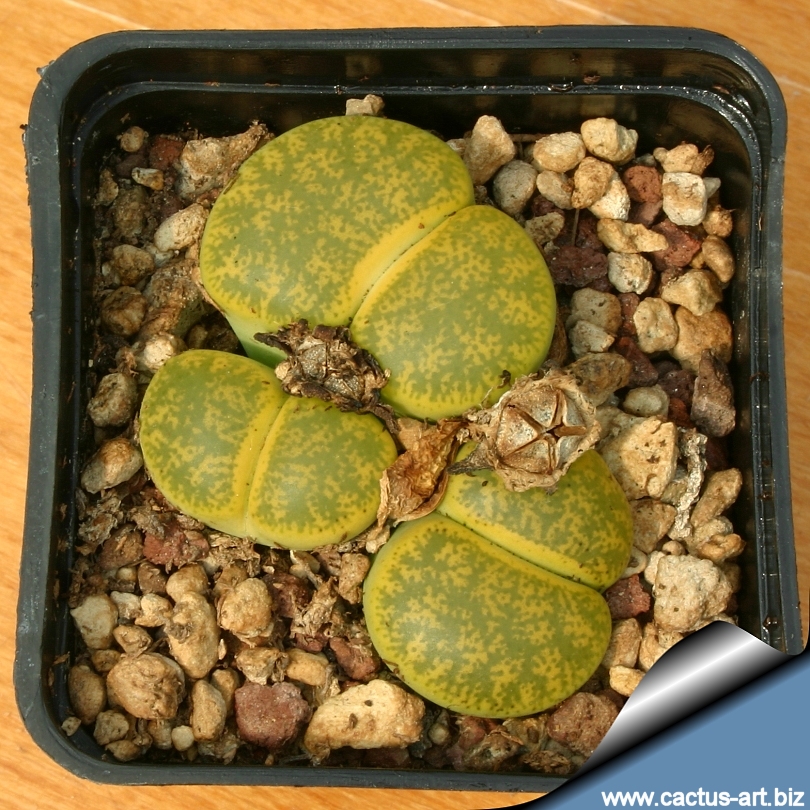
Lithops lesliei cv. albinica C036A
Nice yellowish green body and top with fine intricate green pattern.
|
|
Description: L. lesliei
is among the easiest species to grow and is available in several
distinct subspecies, variety and cultivated forms. It looks like a
flowering brain, with a big, umbrella-shaped daisy flower taking its
nourishment from the frontal lobes. It grows solitary or in small clumps
of 1 to 10 paired leaves (mostly 2 to 5) up to 5 cm wide (often more in
cultivation)
Stem: Almost stemless.
Roots: It has soft rootstocks.
Bodies: quite large 2-4 cm wide. Each plant consists of a pair of
extremely thick and equally or slightly unequally sized leaves fused
together and separated by a shallow fissure (2-5 mm) with conjuncted
lobes. The bodies are shaped like a truncate inverse, gray-green to
buff, cone, flattened to slightly convex in its upper portion.
The top of the leaves is elliptic to slightly reniform and varies
considerably in colour depending on the substrate of origin; the colours
comprises Yellow/brown, greyish/yellow, orange, rust, grey, grey/white,
dark coffee, with a fine lacework of greenish-brown spots, tracing and
furrows. Despite the variability in colour, the shape of this
species is relatively uniform and generally recognizable by its mainly
green windows or channels, and very irregular rust-brown islands with
numerous mini-windows and fairly narrow, distinct and irregular margins
Flowers: A single medium to very large yellow (or rarely white)
daisy-like flower emerges from the fissure and is as large as the pair
of fleshy leaves below. About 3-5 cm wide, diurnal.
Blooming season (Europe): From mid-summer through fall.
Seeds: light to dark brown, very fine.
The
L. lesliei 'albinica'
is a selected cultivar with distinctly translucent, grass green to yellowish sheen with yellow
lines and patches. White flowers. Known only from one
locality in Cape province.
(C036A)
|
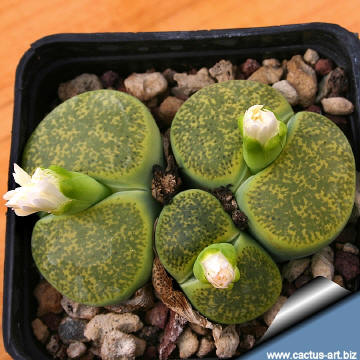
The name "albinica" refers to the white flowers. |
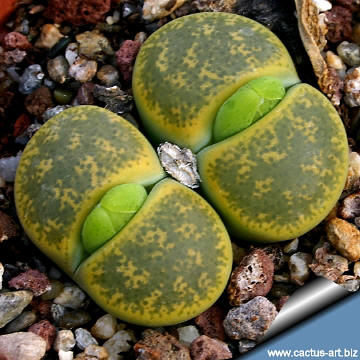
Buds. |
|
. |
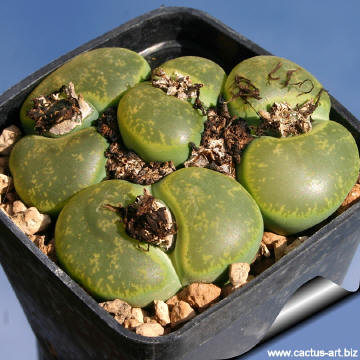 |
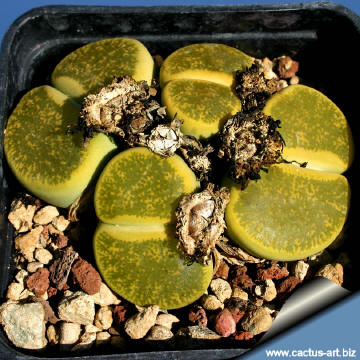 |
|
. |
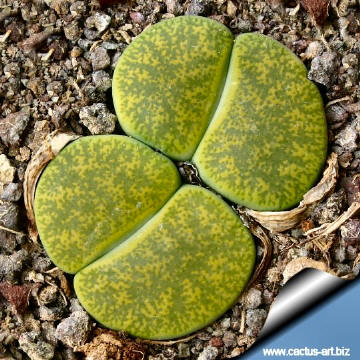 |
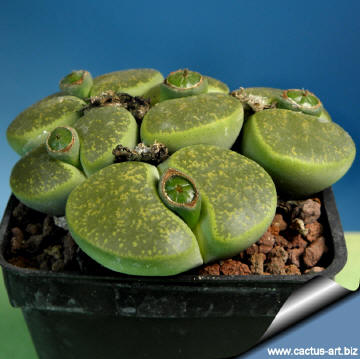 |
|
. |
|
 |

|
|
. |
|
Photo of conspecific taxa,
varieties, forms and cultivars of Lithops lesliei
|
|
Advertising
|
|
|
|
Family: Mesebrianthemaceae (Aizoaceae)
Scientific name: Lithops
lesliei (N.E. Br.) N.E. Br. (1912)
subsp. lesliei var. lesliei
'Albinica' (White flowering + green bodied form)
Origin: (TL)
near Warrenton Northern Cape SA
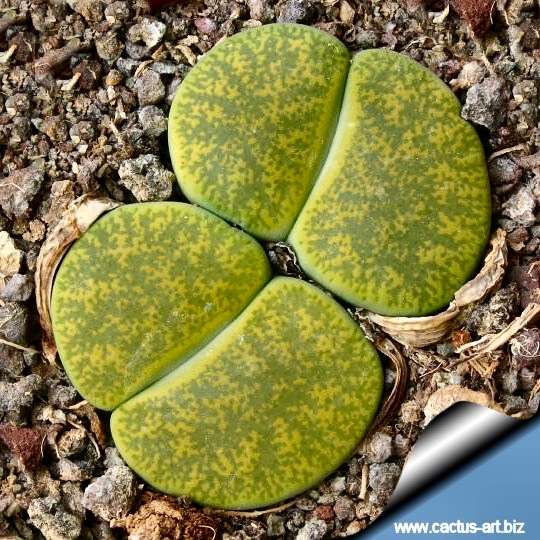 |
|
|
|
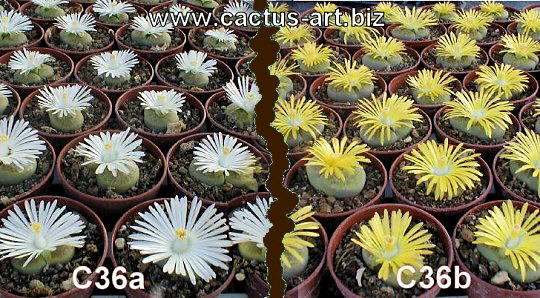
C36a "albinica" white blooms
C36b "Storm's albinigold" yellow flower
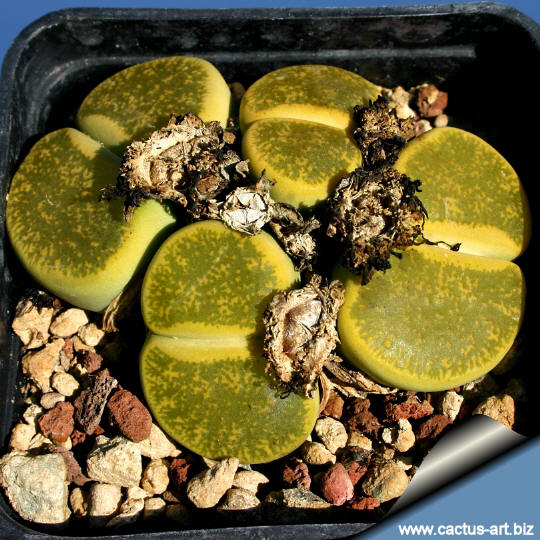
Cultivation: L. lesliei is a summer growing species
with dry rest period over winter. Easy to grow it tolerates a degree
more excess water than some particular hydrophobic species, even so it
must have a very open mineral, fast draining mix with little compost and
a hight degree of grit, coarse sand, small lava gravel or pebbles. Give
them the maximum amount of light you are able to give them, but care
should be taken about exposing them to the full blast of the sun rays in
summer. Such tiny plants can easily get scorched or broiled and their
appearance spoiled (this may not matter in the wild, where the Lithops
have probably shrunk into the ground and becomes covered with sands).
The basic cultivation routine is: Stop watering after flowering. Start
watering after the old leaves completely dry. (Usually late March or
Early April) Water freely during the growing season, soak the compost
fully but allow it to dry out between waterings, no water when
cold. Some growers fertilize frequently, some hardly
ever. Keep them dry during the winter. Nearly all problems occur as a
result of overwatering and poor ventilation especially when weather
conditions are dull and cool or very humid. If too much water is
supplied the plants will grow out of character, bloat, split and rot.
Keep them in small pots as solitary clumps or as colonies in large,
shallow terracotta seed pans.
Note:
After flowering in the
autumn and extending through
winter
season the plant doesn’t need
watering, but they will still be
growing, the new
bodies will be increasing in size extracting
water from the outer
succulent leaves, allowing them to
shrivel away. In fact the plant in this time extracts
water and
nutrient stored in the outer
succulent leaves, allowing them to
dehydrate relocating the water to the rest of the plant and to the
new leaves that form during this period until the old leaves are reduced
to nothing more than "thin papery shells".
Subspecies,
variety & cultivated forms of Lithops lesliei:
-
L. lesliei v. lesliei: Deep rusty
brown with brown windows; flowers golden yellow. (C014, C020, C028,
C036, C026, C151, C344, C352)
-
L. lesliei v. mariae:
Gold specled with clear, orangish body with many very fine, pinspots
darker dots. Yellow flowers. Distribution: RSA: OFS, in a small area
within the range of var. lesliei, to the W of Boshoff and N and NE of
Kimberley. (C141, C152)
-
L. lesliei v. venteri: Grey body with
grey black denticulate windows, like small worms. Yellow flowers.
Distribution: RSA: CP, in a fairly narrow strip on both sides of the
Harts River, extending NE from its confluence with the Vaal River near
Delportshoop to a point near Taung. (C001, C047, C153)
-
L. lesliei acf 'albiflora': Extremely
rare white flowering form, occasionally found in any one colony,
, but in all other respects the plants are indistinguishable from
others in the same colony. They can therefore be identified only when
in flower. (C005A)
-
L. lesliei acf 'albinica':
Distinctly translucent, grass green to yellowish sheen with yellow
lines and patches. White flowers. Known only from one
locality, CP.
(C036A)
-
L. lesliei acf 'Storm's albinigold':
Distinctly translucent, grass green to yellowish sheen with
yellow lines and patches with rich yellow flowers. It is
indistinguishable from acf 'Albinica'. It can therefore be
identified only when in flower.
(C036B)
-
L. lesliei v. hornii: Light ochre to
rusty brown coloured body with greyish brown branching patterning.
Yellow flowers. Endemic to a small area SW and S of
Modderrivier
(C015, C364)
-
L. lesliei v. minor: Yellow-brown to
rusty brown, very similar to the typical form of var. lesliei, but
consistently smaller and with slightly different markings. Yellow
flowers. Distribution: RSA: Tvl, in a very small area to the SW of
Swartruggens, thus within the range of var. lesliei. (C006)
-
L. lesliei v. minor
acf 'Witblom': White
flowering form. It is
indistinguishable from the standar v. minor. It can therefore be
identified only when in flower.
(C006A)
-
L. lesliei v. rubrobrumnea:
Differs from the type variety mainly for the red
brow colour.
Distribution: RSA: Tvl, within the range of var. lesliei, in a very
small area W of Randfontein and Krugersdorp. (C107, C204)
-
L. lesliei subsp.
burchellii:
Distinguished from subsp. lesliei by
colour and markings, and from var. venteri by the much finer
meshlike markings and clavate marginal lines. Origin: RSA: CP, in
small area NE of Douglas. It is probable that this subspecies occurs
also in the military zone further to the NE, along the Vaal River.
(C302, C308)

 |
|